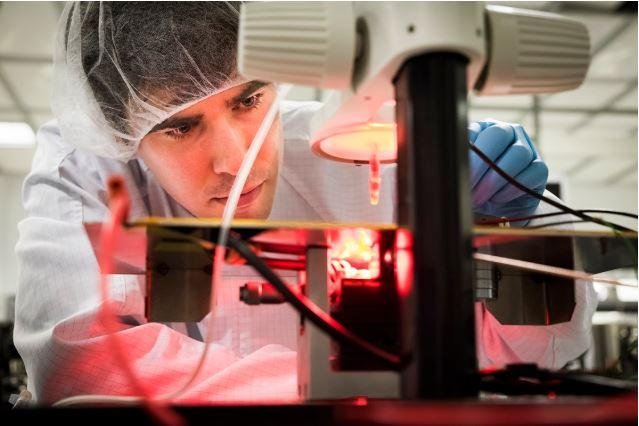Linkoping University researcher Eric Glowacki measures the electrical response of the neurostimulation devices to pulses of red light while developing a system that might restore sight to blind people. Photo by Thor Balkhed/Linkoping University
May 2 (UPI) -- A tiny photoactive film that converts light impulses into electrical signals, which stimulates nerve cells in the eye, is showing promise in restoring sight to blind people, researchers say.
Researchers at Tel Aviv University in Israel and Linköping University in Sweden have developed the system from low-priced organic pigments used in printing inks and cosmetics that convert light impulses from the film into electrical signals and then stimulate the neurons -- or nerve cells -- in retinas. The findings of tests were published Wednesday in the journal Advanced Materials.
"We have shown that our device can be used to stimulate not only neurons in the brain but also neurons in non-functioning retinas," David Rand, a postdoctoral researcher at Tel Aviv University, said in a press release.
In the retina, there are several thin layers of cells. The light-sensitive neurons in the back of the eye convert light to electric signals, while other cells process the nerve impulses and transmit them along the optic nerve to the "visual cortex" in the brain.
A person's sight can be lost because light-sensitive cells were degraded and fail to convert light into electric pulses. An artificial retina, which consists of a thin circular film of photoactive material, similar to an individual pixel in a digital camera sensor, can be surgically implanted.
In the artificial retina, each pixel is about 100 times thinner than a single cell -- smaller than the diameter of a human hair -- and consists of semi-conducting nanocrystals that are commonly used in commercial cosmetics and tattooing ink.
The prosthetic is doughnut-shaped, with the crystal-containing pigment in the middle and a tiny metal ring around it. It has no external connectors, and the nerve cells are activated immediately.
"The response time must be short if we are to gain control of the stimulation of nerve cells," Rand said.
The researchers envision other uses for the system, as well.
"We have optimized the photoactive film for near-infrared light, since biological tissues, such as bone, blood and skin, are most transparent at these wavelengths," said Eric Glowacki, a principal investigator in the Laboratory of Organic Electronics at Linkoping University. "This raises the possibility of other applications in humans in the future."















